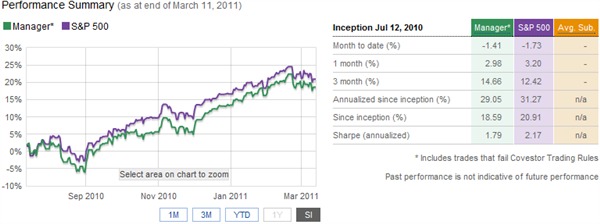 Author: Bristlecone Value Partners
Author: Bristlecone Value Partners
Covestor model: Large Cap Value
Disclosure: Long DELL, XOM, VMC, APOL, PFE, CSCO, WMT, NRG, CX, S, EOG, MXIM

In February, the portfolio roughly matched January’s return, rising approximately 3% again, slightly lower than the S&P 500’s return for the month. Year-to-date as of end of day 3/8, the portfolio is up about 5.7% versus 5.1% for the S&P 500, including dividends.
All sectors went up, with energy, consumer discretionary, and health care leading the way. Industrials, information technology, and utilities lagged. The portfolio’s top contributors to performance were Dell (DELL), Exxon Mobil (XOM), Vulcan Materials (VMC), Apollo (APOL), and Pfizer (PFE). The weakest holdings were Cisco (CSCO), Wal-Mart (WMT), NRG Energy (NRG), Cemex (CX), and Sprint (S).
The big news during the month was the continuing unrest in the Middle East and North Africa. The situation is having a noticeable effect on oil prices, with the benchmark WTI crude index crossing over the $100 level in late February. This clearly benefits two of our companies, Exxon (XOM) and EOG (EOG). Production is not affected: EOG is purely US-based and its top line benefits from higher oil prices. We also anticipate that it might benefit another of our holdings, NRG Energy (more on this below).
At the same time, higher oil prices, particularly as they impact gasoline prices, could have a negative effect on the economic recovery and consumer sentiment around the world and in the US. We feel that the portfolio’s holdings that could potentially be negatively affected are trading at valuation levels that still reflect low expectations and we don’t see any reason to lower our appraisals yet.
During the month, we reduced our investment in Maxim Integrated (MXIM), as the share price approached our assessment of the value of the company. We used the proceeds to increase our investment in both Apollo Group and NRG Energy.
NRG is a wholesale power generation company operating primarily in California, Texas, and the northeast United States. The company is a low cost power producer thanks to its coal and nuclear plants, which represent about two-thirds of its generation capacity.
Power producers are “price takers” and are very sensitive to energy prices both for their revenues and costs. Natural gas, in particular, has a disproportionate impact in that it sets the marginal cost. That is, during peak demand, relatively more expensive power plants are used, and these plants typically use natural gas. These producers submit the highest accepted offer and set spot wholesale prices. As prices for natural gas rise, so do wholesale prices for electricity. Because coal and nuclear are the cheapest source of power generation, NRG’s margins increase with higher natural gas prices.
The fall off in power usage during the recent 2008-2009 recession eased the pressure on wholesale prices, but we expect that imbalances will build again as electricity demand outpaces the construction of power plants in NRG’s markets.
The company’s financial leverage is on the high end of what we consider acceptable, particularly considering the volatility in costs and end prices. Liquidity is good though, and the company makes extensive use of hedges, which helps cash flows. We also like how the company’s recent bargain acquisition of Reliant, a power retailer, provides the company with a built-in hedge against lower prices.
Based on our estimates for margins and free cash flow two or three years out, we feel that the current stock price offers a very attractive risk-reward ratio going forward. The main risk is that natural gas prices remain depressed for longer than we anticipate.

